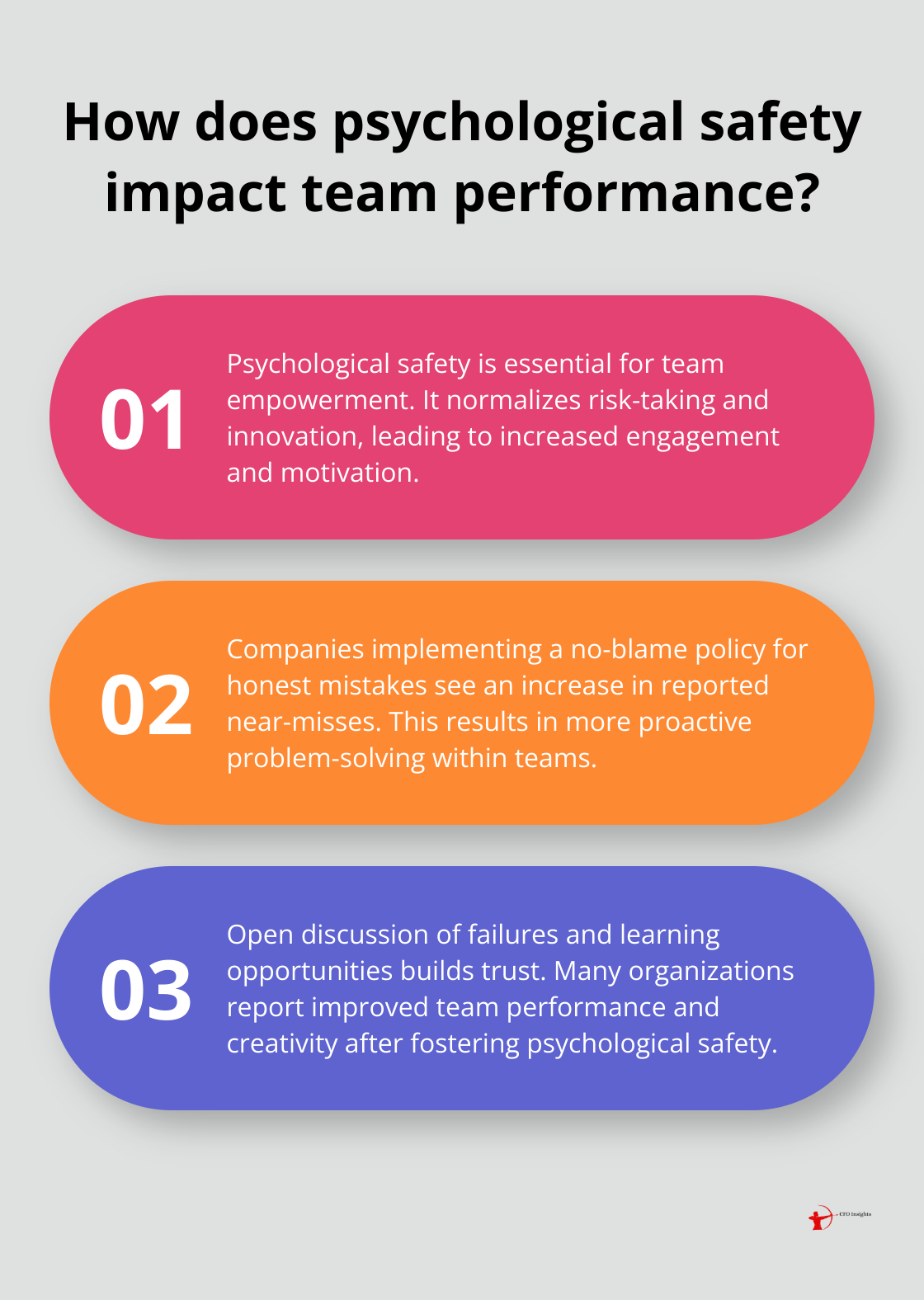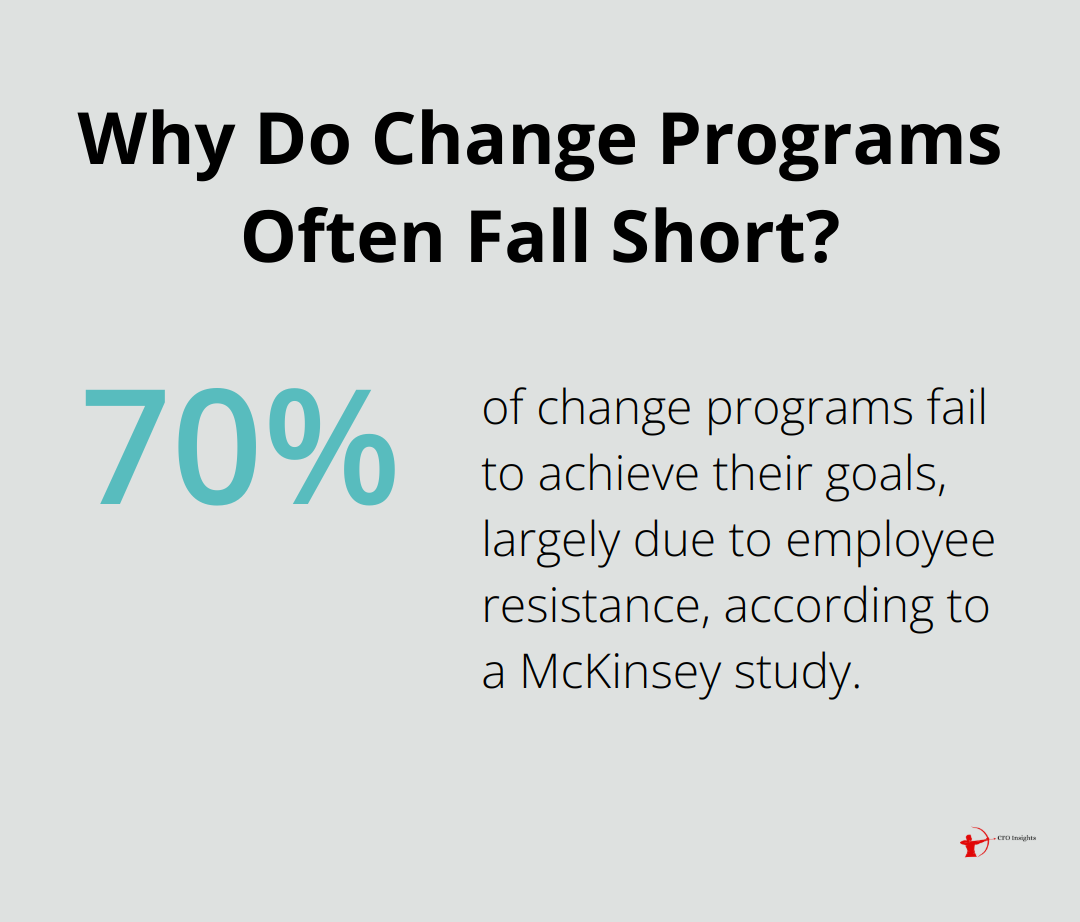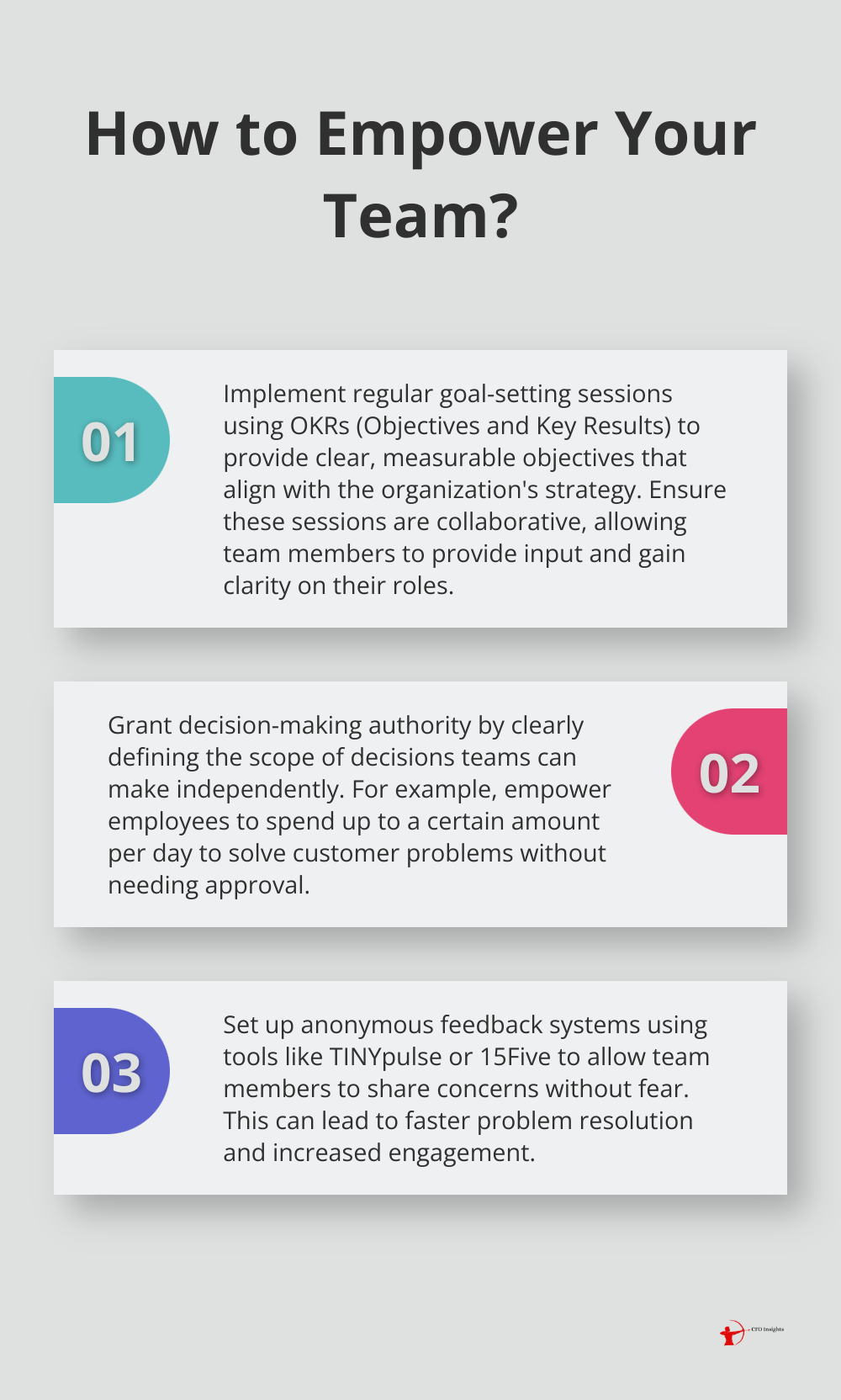Team empowerment is a cornerstone of modern organizational success. At CFO Insights, we’ve seen firsthand how empowered teams drive innovation and productivity.
The effects of transformational leadership on empowerment and team effectiveness are profound, shaping the way organizations operate and grow. In this post, we’ll explore the key elements of team empowerment and provide practical strategies for fostering it within your organization.
What Are the Core Elements of Team Empowerment?
Team empowerment is more than just a buzzword. It represents a fundamental shift in how organizations operate, built on several key elements. We’ve identified four core components that form the foundation of truly empowered teams.
Setting Clear Goals and Expectations
The first step in empowering teams is to provide crystal-clear goals and expectations. This means going beyond vague mission statements. Teams need specific, measurable objectives that align with the organization’s overall strategy. Goal-setting participation positively affects employees’ proactive behavior, and perceived insider status plays a mediating role in this relationship.

To address this, managers should implement regular goal-setting sessions and use frameworks like OKRs (Objectives and Key Results) to ensure everyone is on the same page. These sessions should not be one-way communications but collaborative discussions where team members can provide input and gain clarity on their roles in achieving these goals.
Granting Decision-Making Authority
Empowerment without authority is just empty rhetoric. Teams need the power to make decisions that impact their work. This doesn’t mean a free-for-all where every decision is up for grabs. Instead, it involves clearly defining the scope of decisions that teams can make independently.
For example, Ritz-Carlton empowers its employees to spend up to $2,000 per day per guest to solve problems and not just to satisfy their guests, but to wow them with outside-the-box solutions. This level of decision-making authority not only speeds up problem-solving but also demonstrates trust in the team’s judgment.
Providing Access to Resources and Information
An empowered team is only as good as the resources and information at its disposal. This means breaking down information silos and ensuring that teams have access to the data, tools, and expertise they need to make informed decisions.
In practice, this could involve implementing robust knowledge management systems, providing access to industry reports and market data, or facilitating cross-departmental collaboration. Google’s practice of making nearly all of its information accessible to employees is a prime example of this principle in action.
Building Trust and Support from Leadership
Perhaps the most important element of team empowerment is the trust and support of leadership. This goes beyond just saying “I trust you.” It involves leaders who actively demonstrate their faith in the team’s abilities through their actions and decisions.
A study by the American Psychological Association found that 92% of workers said it is very (57%) or somewhat (35%) important to them to work for an organization that values their emotional and psychological well-being. Leaders can address this by providing constructive feedback, acknowledging team successes, and standing behind the team’s decisions (even when things don’t go as planned).
Implementing these core elements of team empowerment isn’t a one-time task but an ongoing process. It requires consistent effort and a willingness to adapt as the team and organization evolve. Now that we’ve established the foundation of team empowerment, let’s explore specific strategies to foster this environment within your organization.
How to Foster Team Empowerment
At CFO Insights, we know that fostering team empowerment requires deliberate action and commitment. Here are practical strategies that work effectively across various organizations.
Create Open Communication Channels
Open communication fuels empowered teams. Practice mindfulness and take action to be transparent with your team members. Proactively answer their questions, and give them context about important decisions and changes. This approach has boosted engagement in many organizations.

Set up anonymous feedback systems. Tools like TINYpulse or 15Five allow team members to share concerns without fear. Many companies see an increase in reported issues after implementing such systems, leading to faster problem resolution.
Invest in Continuous Learning
Empowerment thrives on competence. Allocate a specific budget for each team member’s professional development. Discover strategies to create employee development plans that boost retention and performance.
Implement a mentorship program. Pair junior team members with more experienced colleagues. This approach transfers knowledge and builds relationships across the organization. Many firms report reduced onboarding time for new hires with this method.
Reward Initiative and Innovation
Create a formal recognition program for innovative ideas. Some companies allow employees to spend a percentage of their work time on projects of their choosing (leading to groundbreaking products in some cases). Even a small time allocation can spark creativity.
Implement a points-based reward system. Team members can earn points for taking initiative, which they can redeem for tangible rewards. Many organizations see an increase in employee-driven process improvements after implementing such systems.
Build Psychological Safety
Psychological safety is essential for empowerment. Start by openly discussing failures and what you can learn from them. This normalizes risk-taking and innovation.
Implement a no-blame policy for honest mistakes. Psychological safety leads to team members feeling more engaged and motivated because they feel that their contributions matter. Many companies see an increase in reported near-misses after implementing this policy, leading to proactive problem-solving.
Fostering team empowerment requires tailoring these strategies to your organization’s unique culture and needs. The key lies in consistency and a genuine commitment to empowering your team. However, empowerment isn’t without its challenges. In the next section, we’ll explore common obstacles and how to overcome them.
Navigating the Hurdles of Team Empowerment
Team empowerment presents various challenges for organizations. Let’s explore these obstacles and discuss practical solutions to overcome them.
Overcoming Resistance to Change
Change often faces resistance, and team empowerment is no exception. A McKinsey study found that 70% of change programs fail to achieve their goals, largely due to employee resistance. To combat this, we recommend a phased approach to empowerment.

Organizations should start with small, low-risk decisions and gradually increase the scope. For example, allow teams to decide on their meeting schedules or project tools before moving to more significant decisions. This gradual approach builds confidence and demonstrates the benefits of empowerment in action.
Additionally, involve team members in the empowerment process from the start. Conduct workshops where employees can voice their concerns and contribute ideas. This involvement often turns resistors into advocates.
Striking the Balance: Autonomy and Accountability
Empowerment without accountability can lead to chaos. The key is to establish clear performance metrics alongside increased autonomy. Using OKRs (Objectives and Key Results) works well for many organizations.
Set team-level OKRs that align with company goals, but let teams decide how to achieve them. This approach provides direction while preserving autonomy. Regular check-ins (perhaps bi-weekly) help ensure teams stay on track without micromanagement.
It’s also important to address underperformance promptly. Have a clear process for performance improvement that respects the team’s autonomy while addressing issues. This might involve peer feedback sessions or team-led improvement plans.
Managing Disagreements in Empowered Teams
Empowered teams often experience more conflicts as diverse opinions come to the forefront. While this can be positive, it needs management.
Implement a structured conflict resolution process. Train team members in techniques like the Thomas-Kilmann Conflict Mode Instrument to help them navigate disagreements constructively. Encourage teams to establish their own conflict resolution protocols, fostering ownership of the process.
Create spaces for constructive disagreement. Some companies use techniques like “devil’s advocate” roles in meetings to ensure all perspectives are considered. This approach can turn potential conflicts into opportunities for innovation.
Aligning Empowered Teams with Organizational Goals
As teams become more autonomous, there’s a risk of misalignment with broader organizational objectives. To prevent this, transparency is key. Share company-wide goals and strategies regularly and explicitly.
Implement a cascading goal system where team objectives visibly link to organizational goals. Schedule quarterly alignment sessions where teams present their goals and receive feedback on alignment.
Encourage cross-team collaboration to maintain a broader perspective. Rotate team members through different departments or create cross-functional project teams. This exposure helps employees understand how their work fits into the bigger picture.
Final Thoughts
Team empowerment serves as a powerful catalyst for organizational success. Clear goals, decision-making authority, resource access, and leadership trust form its foundation, while open communication and continuous learning create an environment where teams thrive. The effects of transformational leadership on empowerment and team effectiveness lead to increased innovation, higher job satisfaction, and improved productivity.

Implementing team empowerment requires a thoughtful approach. Organizations should assess their current culture, identify high-impact areas, and gradually increase team autonomy. Investing in leadership and team skill development programs will support this transition (regular strategy reviews based on feedback and results are essential).
At CFO Insights, we specialize in helping organizations optimize their finance teams and implement growth-driving strategies. Our fractional CFO services provide the expertise needed to align financial strategies with empowerment goals. Contact us to position your organization for success in today’s dynamic business environment.
One thought on “What Does Team Empowerment Consist Of?”
Leave a Reply
You must be logged in to post a comment.





[…] team management strategies are crucial for the success of any organisation. In a recent article on team empowerment, the importance of empowering team members to take ownership of their work and make decisions […]